Family : Serranidae

Text © Giuseppe Mazza

English translation by Mario Beltramini
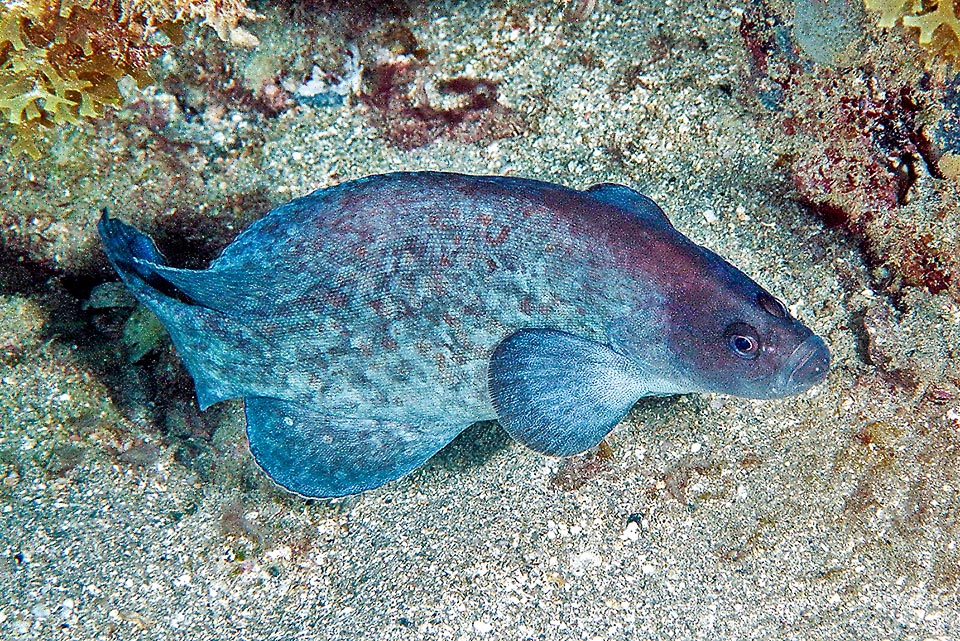
Rypticus saponaceus is an atypical serranid, with very long body compressed on the sides, present in the Atlantic Ocean tropical and subtropical waters © Kevin Bryant
Rypticus saponaceus (Bloch & Schneider, 1801) belongs to the class of the Actinopterygii, the ray-finned fishes, to the order of the Perciformes, to the family Serranidae and to the subfamily Grammistinae that includes 7 genera and about twenty species present in the coral formations of all the oceans. Some prefer however to raise this subfamily to the rank of family, the Grammistidae, who should have 8 genera and 32 species.
The etymology of the genus Rypticus originates from the Greek “ryptikos”, with reference to the wahins, as however is confirmed by the Latin term saponaceus, soapy, because it is a fish covered by a slimy mucus produced by under skin glands that transforms into a soapy foam when it feels to be in danger.
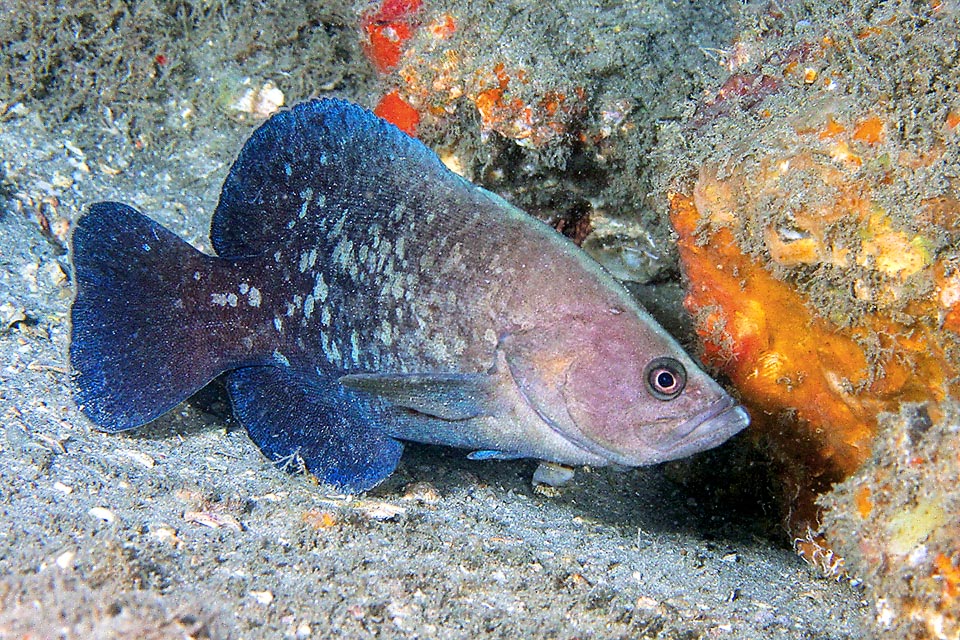
Has no spiny rays on the anal fin and the dorsal usually has 3 of them and with 23-26 soft rays opening like a sail towards the tail © Kevin Bryant
An unusual form of defense, confirmed also by the common name of Greater soapfish or Common soapfish, not only because it is difficult to grasp it, but because this mucus is infused with grammistin, a poison not dangerous to man, present also in Grammistes sexlineatus.
Its smell scares the predators and in confined environments, like an aquarium, may kill the other guests.
Zoogeography
Rypticus saponaceus has a very vast range in the Atlantic Ocean tropical and subtropical waters.
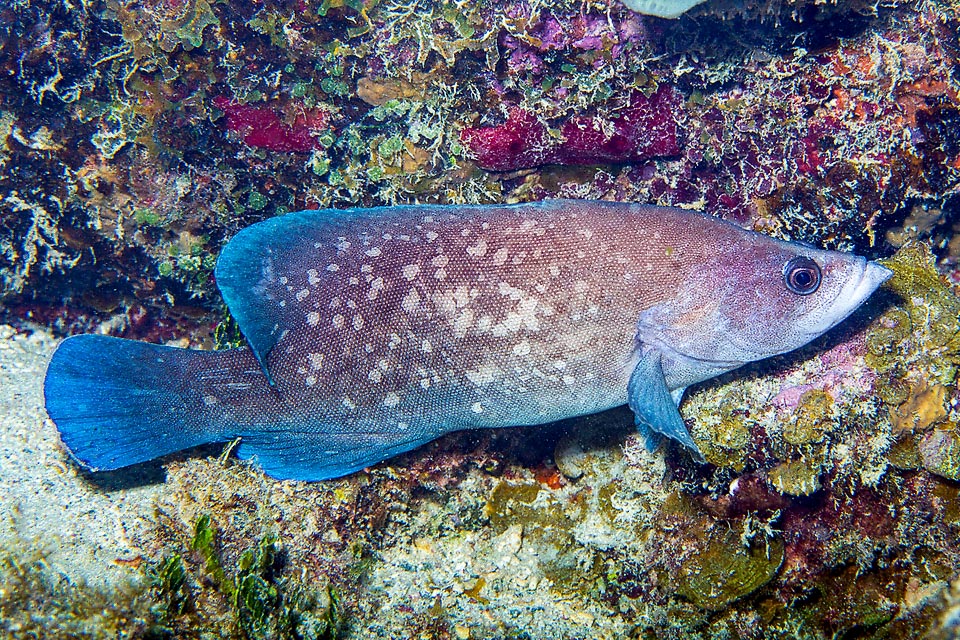
The lower jaw is protruding with an unusual fleshy knob. The livery, greyish brown with irregular clear spots, often tends to violet blue, especially on the fins © Allison & Carlos Estape
In America it is present, starting from the Bermudas and Florida, in the Gulf of Mexico and along all coasts of the Caribbean Sea up to Venezuela and Brazil and then, in the ocean, in Saint Peter and Saint Paul archipelago as well as in the Trindade and Martim Vaz one and in Saint Helena island. Finally, in the Old World, it is present, after Cape Verde islands, along the African coasts from Mauritania to Angola.
Ecology-Habitat
Rypticus saponaceus is a solitary benthic fish living usually in shallow waters, between 2 and 20 m of depth, but can reach even 70 m and they talk of a record of 213 m.
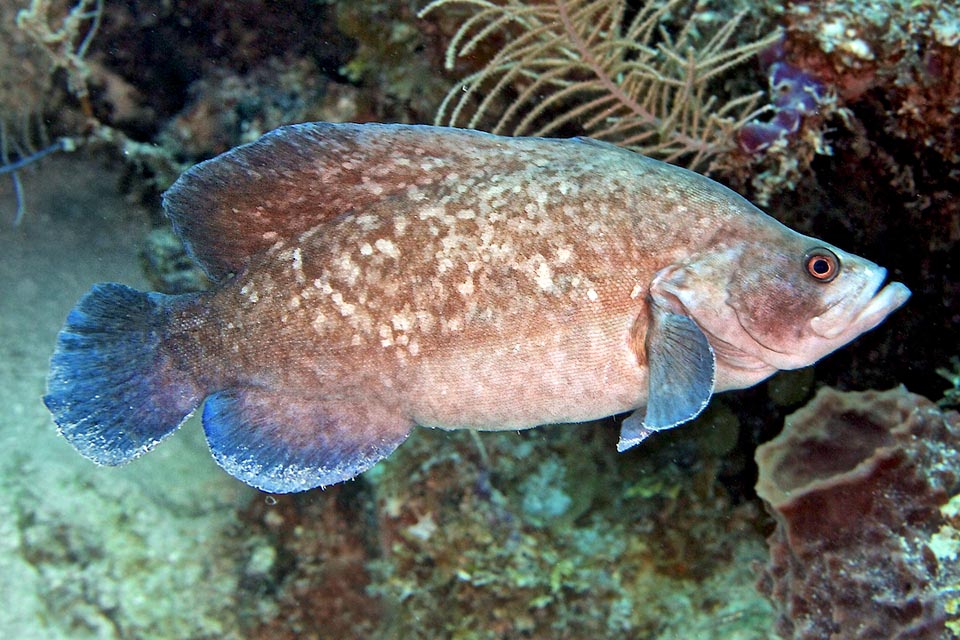
Rypticus samponaceus is called Soapfish because it’s protected by a slimy poisonous mucus, the grammistin, that transforms in soapy foam when it feels threatened © Allison & Carlos Estape
Active mainly during the night, it is not easy to observe during the light hours because it rests hidden in the ravines of the seabed, but may be found also in open spaces in broad daylight while it goes swimming in the clear waters of the coral reefs, along the rocky coasts on gravelly bottoms, but also on the soft and silty ones.
Morphophysiology
20-25 cm at most with a top of 30 cm, Rypticus saponaceus is an atypical serranid. In addition to a thin and elongated body, unlike Epinephelus marginatus and Serranus tigrinus just as an example in the vast subfamilies of the Epinephelinae and of the Serraninae, in fact has no spiny rays on the anal fin.
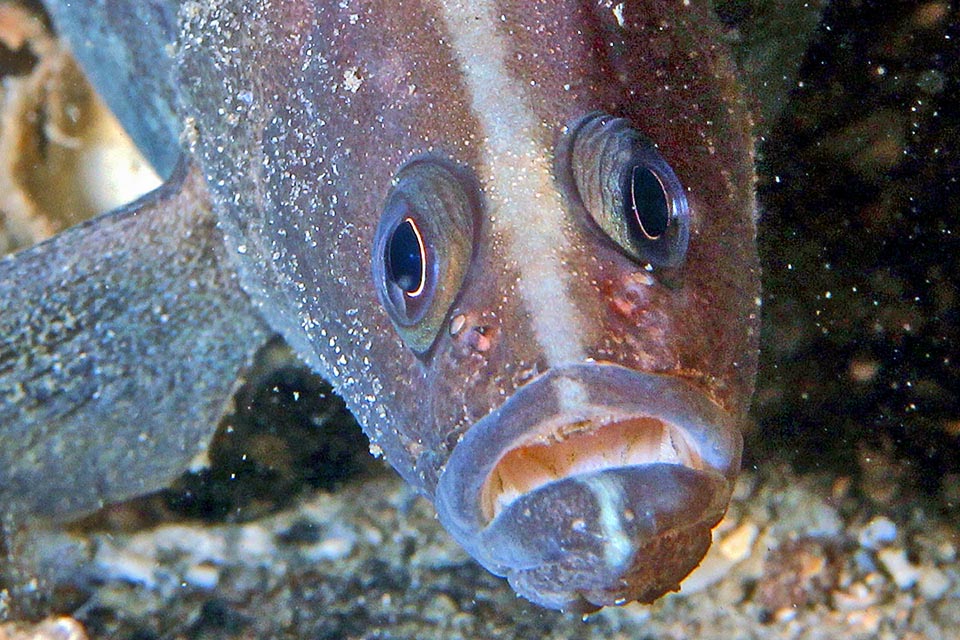
It eats small crustaceans, mollusks and small fishes. There are no sharp canines, but simple teeth arranged in bands that confer a velvety look inside mouth © Kevin Bryant
Moreover, the dorsal, usually rich in spines, has only 2-4 aculeate rays, with 23-26 soft rays that open like a sail towards the tail, almost as tall as the body.
The pelvic fins, of reduced size, are located more forward than the pectoral ones, and these, with 14-17 rays, appear rounded as well as the caudal fin.
The front is slightly concave, and even if the head has a protruding lower jaw, like in the groupers, this ends up with an unusual fleshy brush.
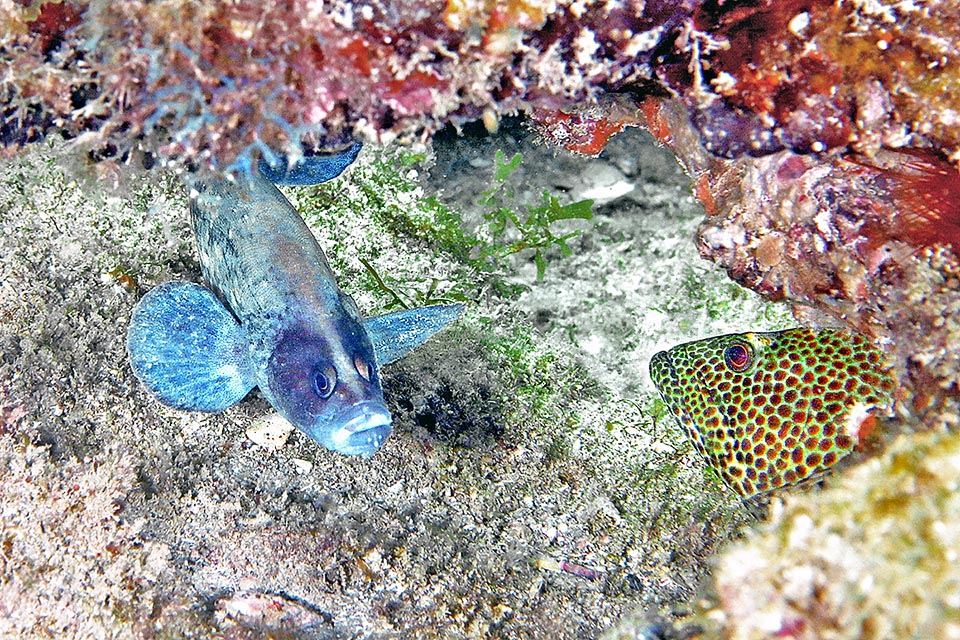
Two serranids compared. Ryoticus saponaceus belongs to subfamily Grammistinae whilst the grouper (Cephalopholis cruentata) to Epinephelinae subfamily © Kevin Bryant
Finally, there are no pointed canines, but simple teeth arranged in rows that almost confer a velvety look to the inside of the mouth.
The edge of the preoperculum and of the operculum have a maximum of three spines, and the latter is merged on the top to the skin, partially reducing the gill opening.
The scales are tiny and the greyish brown livery, with irregular clear spots and more or less dark cheeks depending on the circumstances, tends to violet blue especially on the fins.
Ethology-Reproductive Biology
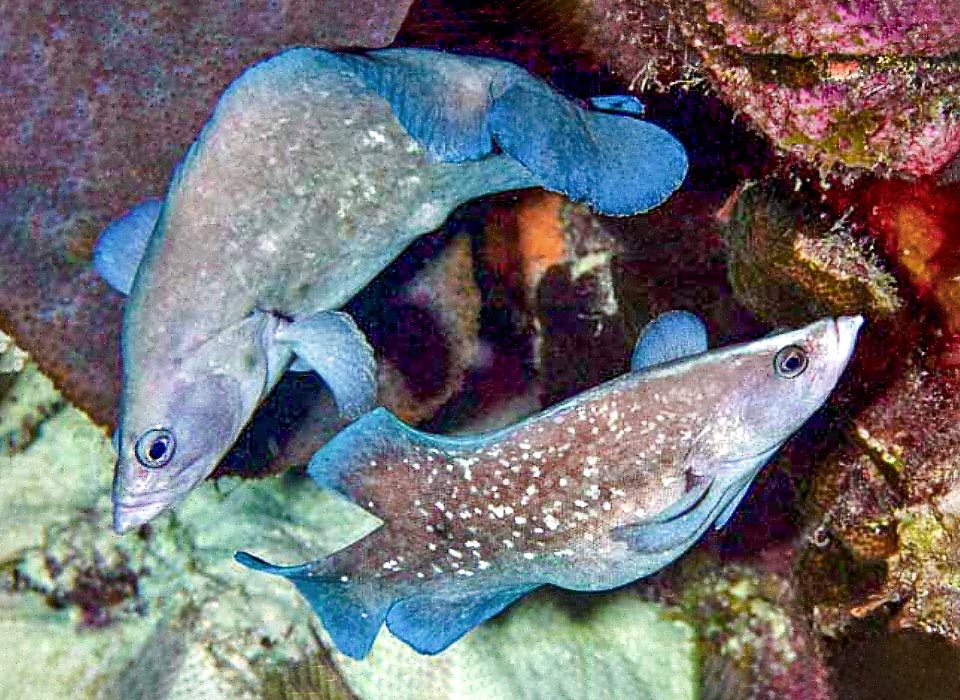
Couple rising in parade towards the surface for spawning. The eggs are entrusted to the currents © Allison & Carlos Estape
Rypticus saponaceus nourishes of small crustaceans, mollusks and small fishes, like, for instance, the
Apogonidae.
The reproduction is still to be studied but it is known that it is a protogynous hermaphroditic species, that is with females thay may transform into males, which is not uncommon after all among the Serranidae.
It seems that the couples rise to the surface at the end of the day and, as happens with groupers, the fecundated eggs are entrusted to the currents. Also the larvae are pelagic and this explains the wide diffusion of the species.
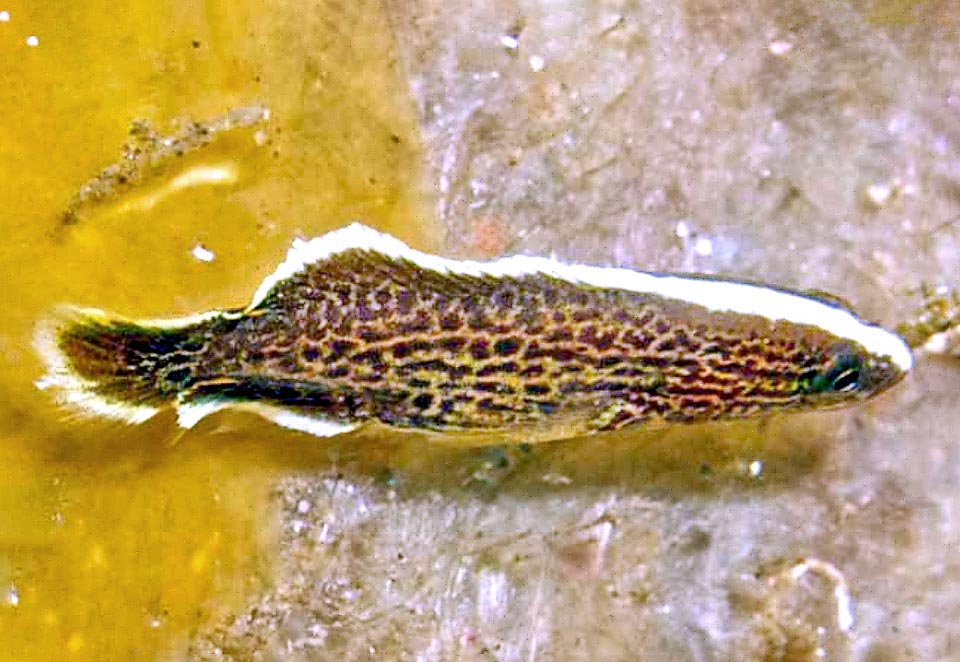
Also larvae are pelagic and reaching distant shores diffuse the species. Here a juvenile. The livery is quite different but we already note the clear stripe starting from head © Ray Haberman
The resilience is unknown, but the fishing vulnerability is low marking only 25 on a scale of 100. After all, even if it runs into the nets and is at times locally consumed, it’s a fish of poor value. However, in Ghana it is sold dried at the Elmina fish market.
So Rypticus saponaceus appears since 2012 as “LC, Least Concern“ in the IUCN Red List of the endangered species.
Synonyms
Anthias saponaceus Bloch & Schneider, 1801.
→ For general information about FISH please click here.
→ For general information about BONY FISH please click here
→ For general information about CARTILAGINOUS FISH please click here.
→ To appreciate the BIODIVERSITY of BONY FISH please click here.
→ To appreciate the BIODIVERSITY of CARTILAGINOUS FISH please click here.
